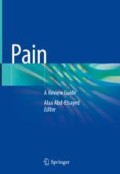Abstract
There are different mechanisms that modify or modulate a pain signal along its pathway. Pain modulation occurs peripherally or centrally at the level of the spinal cord or supraspinal structures. Sensitization of the receptors can lead to hyperalgesia. Peripheral hyperalgesia can be primary or secondary. Sensitization can also occur centrally due to segmental and spinal cord mechanisms leading to facilitation of transmission of the pain signal. Central hypersensitization is commonly referred to as the “Wind-up” phenomenon. Changes in neurochemistry of the dorsal horn due to repetitive stimulation as well as recruitment of non-neuronal cells, such as astrocytes and microglial cells, are believed to play an important role in central sensitization. Inhibition occurs at both spinal and supraspinal levels due to different mechanisms. Gate control theory, concomitant release of inhibitory neurotransmitters, and descending inhibitory pathways are different mechanisms that lead to inhibition.
Access this chapter
Tax calculation will be finalised at checkout
Purchases are for personal use only
References
Fields HL. Central nervous system mechanisms for control of pain transmission. In: Fields HL, editor. Pain. New York: McGraw-Hill; 1987. p. 99.
Dray A. Inflammatory mediators of pain. Br J Anesth. 1995;75:125–31.
Bonica JJ. Anatomic and physiologic basis of nociception and pain. In: Bonica JJ, editor. The management of pain. 2nd ed. Philadelphia: Lea and Febiger; 1990. p. 128.
Cook AJ, Woolf CJ, Wall PD. Dynamic receptive field plasticity in rat spinal cord dorsal horn following C-primary afferent input. Nature. 1987;325:151.
Wall PD, Woolf CJ. The brief and prolonged facilitatory effects of unmyelinated afferent input on the rat spinal cord are independently influenced by peripheral nerve section. Neuroscience. 1986;17:1199.
Schnitzler M, Kilbride M, Senagone A. Effect of epidural analgesia on colorectal anastomotic healing and colonic motility. Reg Anesth. 1997;59:6–9.
Author information
Authors and Affiliations
Corresponding author
Editor information
Editors and Affiliations
Rights and permissions
Copyright information
© 2019 Springer Nature Switzerland AG
About this chapter
Cite this chapter
Zaky, S., Zaky, C.S., Abd-Elsayed, A. (2019). Segmental and Brain Stem Mechanisms. In: Abd-Elsayed, A. (eds) Pain. Springer, Cham. https://doi.org/10.1007/978-3-319-99124-5_6
Download citation
DOI: https://doi.org/10.1007/978-3-319-99124-5_6
Published:
Publisher Name: Springer, Cham
Print ISBN: 978-3-319-99123-8
Online ISBN: 978-3-319-99124-5
eBook Packages: MedicineMedicine (R0)

